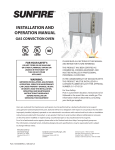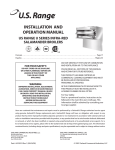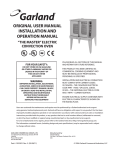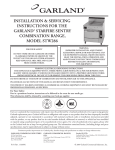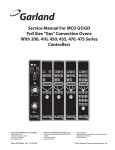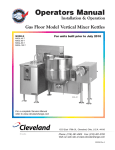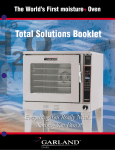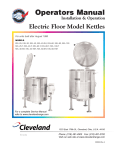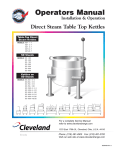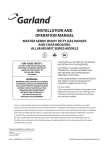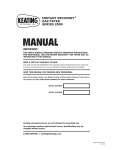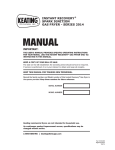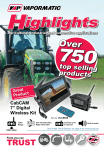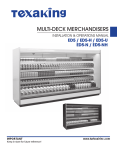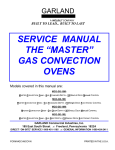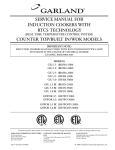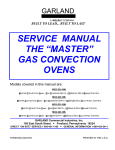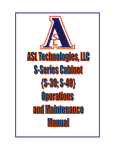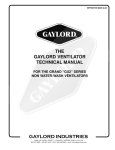Download INSTALLATION AND OPERATION MANUAL
Transcript
INSTALLATION AND
OPERATION MANUAL
"THE MASTER"
GAS CONVECTION OVEN
FOR YOUR SAFETY:
DO NOT STORE OR USE GASOLINE
OR OTHER FLAMMABLE VAPORS OR
LIQUIDS IN THE VICINITY OF
THIS OR ANY OTHER
APPLIANCE
WARNING:
IMPROPER INSTALLATION, ADJUSTMENT,
ALTERATION, SERVICE OR MAINTENANCE
CAN CAUSE PROPERTY DAMAGE, INJURY,
OR DEATH. READ THE INSTALLATION,
OPERATING AND MAINTENANCE
INSTRUCTIONS THOROUGHLY
BEFORE INSTALLING OR
SERVICING THIS EQUIPMENT
PLEASE READ ALL SECTIONS OF THIS MANUAL
AND RETAIN FOR FUTURE REFERENCE.
THIS PRODUCT HAS BEEN CERTIFIED AS
COMMERCIAL COOKING EQUIPMENT AND
MUST BE INSTALLED BY PROFESSIONAL
PERSONNEL AS SPECIFIED.
IN THE COMMONWEALTH OF MASSACHUSETTS
THIS PRODUCT MUST BE INSTALLED BY A
LICENSED PLUMBER OR GAS FITTER. APPROVAL
NUMBER: G-1-07-05-28
For Your Safety:
Post in a prominent location, instructions to be
followed in the event the user smells gas. This
information shall be obtained by consulting
your local gas supplier.
Users are cautioned that maintenance and repairs must be performed by a Garland authorized service agent
using genuine Garland replacement parts. Garland will have no obligation with respect to any product that has been
improperly installed, adjusted, operated or not maintained in accordance with national and local codes or installation
instructions provided with the product, or any product that has its serial number defaced, obliterated or removed,
or which has been modified or repaired using unauthorized parts or by unauthorized service agents.
For a list of authorized service agents, please refer to the Garland web site at http://www.garland-group.com.
The information contained herein, (including design and parts specifications), may be superseded and is subject
to change without notice.
Manufactured by:
Cleveland Range
1333 East 179th Street
Cleveland,Ohio USA 44110
Part # 1955200 Rev 6 (07/03/12)
GARLAND COMMERCIAL RANGES, LTD.
1177 Kamato Road, Mississauga, Ontario L4W 1X4
CANADA
Phone: 905-624-0260
Fax: 905-624-5669
© 2005 Garland Commercial Industries, LLC
Enodis U
Swallowfiel
Telephone:
Fax: 081-84
IMPORTANT INFORMATION
WARNING:
This product contains chemicals known to the state of California to cause cancer and/or birth defects
or other reproductive harm. Installation and servicing of this product could expose you to airborne
particles of glass wool/ceramic fibers. Inhalation of airborne particles of glass wool/ceramic fibers
is known to the state of California to cause cancer. Operation of this product could expose you to
carbon monoxide if not adjusted properly. Inhalation of carbon monoxide is known to the state of
California to cause birth defects or other reproductive harm.
Keep appliance area free and clear of combustibles.
Page 2
Part # 1955200 Rev.6 (07/03/12)
CONTENTS
IMPORTANT INFORMATION . . . . . . . . . . . . 2
DIMENSIONS & SPECIFICATIONS . . . . . . . . 4
Master 475 Electronic Programmable Control. 12
Manual cooking . . . . . . . . . . . . . . . . . . . . . . . . . 12
Manual cooking using Cook-N-Hold . . . . . . 12
INTRODUCTION . . . . . . . . . . . . . . . . . . . . . . . 5
Programming Product Keys (Master 475) . . 13
INSTALLATION . . . . . . . . . . . . . . . . . . . . . . . . 5
Cooking using the product keys
(Master 475) . . . . . . . . . . . . . . . . . . . . . . . . . . . . . 14
Installation Notes:. . . . . . . . . . . . . . . . . . . . . . . . . . . . 5
Verifying hold time (Master 475) . . . . . . . . . . 14
Installation Of Ovens Equipped With Casters. . 5
Cooking with the Shelf Timer
(Master 475) . . . . . . . . . . . . . . . . . . . . . . . . . . . . . 14
Installation Of Double Deck Models. . . . . . . . . . . 6
Gas Connection. . . . . . . . . . . . . . . . . . . . . . . . . . . . . . 7
PERFORMANCE RECOMMENDATIONS . . 15
Electrical Connection . . . . . . . . . . . . . . . . . . . . . . . . 7
COOKING GUIDE . . . . . . . . . . . . . . . . . . . . . 16
Ventilation & Air Supply. . . . . . . . . . . . . . . . . . . . . . 7
Testing & Lighting Instructions . . . . . . . . . . . . . . . 8
COOK AND HOLD . . . . . . . . . . . . . . . . . . . . . 17
OPERATION . . . . . . . . . . . . . . . . . . . . . . . . . . . 9
PROBLEMS / SOLUTIONS . . . . . . . . . . . . . . 18
Master 200 Solid State Control With
Electromechanical Timer. . . . . . . . . . . . . . . . . . . . . 9
CLEANING & MAINTENANCE . . . . . . . . . . 19
In Off Mode . . . . . . . . . . . . . . . . . . . . . . . . . . . . . . 9
Start Up . . . . . . . . . . . . . . . . . . . . . . . . . . . . . . . . . . 9
Fan Speed . . . . . . . . . . . . . . . . . . . . . . . . . . . . . . . . 9
Lights . . . . . . . . . . . . . . . . . . . . . . . . . . . . . . . . . . . . 9
Cool Down . . . . . . . . . . . . . . . . . . . . . . . . . . . . . . . 9
Break-In Period . . . . . . . . . . . . . . . . . . . . . . . . . . 19
Exterior Cleaning . . . . . . . . . . . . . . . . . . . . . . . . 19
Interior Cleaning . . . . . . . . . . . . . . . . . . . . . . . . . 19
Fan Area Maintenance . . . . . . . . . . . . . . . . . . . 19
MOTOR CARE . . . . . . . . . . . . . . . . . . . . . . . . 20
Temperature . . . . . . . . . . . . . . . . . . . . . . . . . . . . . . 9
Timer: . . . . . . . . . . . . . . . . . . . . . . . . . . . . . . . . . . . 10
Master 450 Electronic Control With
Cook-N-Hold And Master 455 Electronic
Control With Cook-N-Hold & Core Probe. . . . . 10
In Off Mode . . . . . . . . . . . . . . . . . . . . . . . . . . . . . 10
On Start Up . . . . . . . . . . . . . . . . . . . . . . . . . . . . . . 10
Controller Keys . . . . . . . . . . . . . . . . . . . . . . . . . . 10
Fahrenheit/Celsius . . . . . . . . . . . . . . . . . . . . . . . 11
Operating the Controls . . . . . . . . . . . . . . . . . . . 11
Cook-N-Hold Operation . . . . . . . . . . . . . . . . . . 12
Core Probe Operation . . . . . . . . . . . . . . . . . . . . 12
Setting Setback Feature . . . . . . . . . . . . . . . . . . 12
Part # 1955200 Rev.6 07/03/12)
Page 3
DIMENSIONS & SPECIFICATIONS
Int. Dimensions :In (mm)
Single-Deck
Models
W
H
D
Ext. Dimensions: In (mm)
W
Standard Depth 29 (736) 24 (610) 24 (610) 38 (965)
Deep Depth
Double-Deck
Models
29 (736) 24 (610) 28 (711) 38 (965)
Int. Dimensions: In (mm)
W
H
D
Ship Wt
Ship Dim.
H*
D
Lbs/kg
Cubic Ft.
57-1/2 (1461)
41-1/4(1048)
515/230
64
57-1/2 (1461)
44-1/2(1130)
545/245
64
Ship Wt.
Ship Dim.
Ext. Dimensions: In (mm)
W
H*
D
2@Lbs/kg
Cubic Ft.
Standard Depth
29 (736) 24 (610) 24 (610) 38 (965)
70-1/2 (1791)
41-1/4(1048)
1030/465
128
Deep Depth
29 (736) 24 (610) 28 (711) 38 (965)
70-1/2 (1791)
44-1/2(1130)
1090/490
128
*Height with or without standard casters. Height with low profile casters (double deck) is 68-1/2" (1740mm).
Input Ratings, Nat & Pro
Models
Electrical Specifications
BTU/hr
kW Equiv.
Gas Inlet
120V/1Ph.
240V/1Ph.
Single Deck
60,000
17. 6
(1 )@ 3/4" NPT
(1)@9.8A
(1)@ 5.2A
Double Deck
120,000
35.2
(1 )@1" NPT
(2)@9.8A
(2)@ 5.2A
3/4" N.PT.
GAS INLET
2"
[51mm]
7-3/4"
[197mm]
3/4"
[19mm]
D
1" REAR
GAS INLET
1-1/4"
[32mm]
32-1/8"
[816mm]
32-1/8"
[816mm]
FLUE: 2-3/8"x5"
[60mmx127mm]
38-1/4"
[972mm]
(includes
fan motor)
H
32-1/8"
[816mm]
32-1/8"
[816mm]
17-3/4"
[451mm]
6-1/4"
[159mm]
TOP VIEW
1-1/4"
[32mm]
35-7/16”
[900mm]
11-1/2"
[292mm]
38"
[965mm]
3/4" REAR
GAS INLET
32-1/8"
[816mm]
H
54-9/16"
[1386mm]
34"
[864mm]
25-3/8"
[645mm]
SINGLE DECK
FR ONT VIEW
Installation Notes:
Combustable Wall Clearances:
Sides: 1" (25mm)
Back: 3" (76mm)
Entry Clearance:
Crated: 47" (1194mm)
Uncrated: 32-1/2" (826mm)
DOUBLE DECK
FR ONT VIEW
14-3/4"
[375mm]
Operating Pressure:
Natural: 4." WC (10 mbar)
Propane: 10" WC (25 mbar)
Max 13.8" WC @ 70°F (21°C)
NOTE: Data applies only to
North America
Notes:
1. Standard electrical specifications include motor requirements.
2. (120V units) 115V 3/4 HP, 2‑speed motor; 1140 and 1725 rpm 60Hz
3. (240V units) 200‑240V, 3/4 HP, 2‑speed motor; 1140 and 1725 rpm, 60Hz
4. A 6 ft. line cord is provided for each 120V deck with a (NEMA #5‑15P) plug.
5. Garland recommends a separate 15 AMP circuit for each 120V unit.
Gas Input ratings shown here are for installations up to 2,000-ft. (610m) above sea level. Specify altitudes over 2,000 ft.
Commercial cooking equipment requires an adequate ventilation system. For additional information, refer to the National Fire
Protection Association’s standard NFPA96, “Vapor Removal from Cooking Equipment.” (NOTE: For North America only)
Please specify gas type when ordering.
Page 4
Part # 1955200 Rev.6 (07/03/12)
INTRODUCTION
CONGRATULATIONS! You have just purchased the finest
commercial cooking equipment available anywhere.
Like any other fine, precision built appliance, it should be
given regular care and maintenance. Periodic inspections by
your dealer or a qualified service agency is recommended.
When corresponding with the factory or your local authorized
factory service center regarding service problems or
replacement parts, be sure to refer to the particular unit by
the correct model number (including the prefix and suffix
letters and numbers) and the warranty serial number. The
rating plate located behind the lower front panel (below the
oven doors) contains this information.
INSTALLATION
Installation Notes:
Combustible and Non-Combustible Wall Clearance:
Side: 1.0" (25 mm)
Rear: 3.0" (76 mm).
NOTE: Adequate clearance must be provided for servicing
and proper operation.
The importance of the proper installation of Commercial
Gas Cooking Equipment cannot be over stressed. Proper
performance of the equipment is dependent, in great part,
on the compliance of the installation with the manufacturer's
specifications. Installation must conform to local codes or, in
the absence of local codes, with the National Fuel Code, ANSI
Z223.1, Natural Gas Installation Code, CAN/CGA-B149.1, or the
Propane Installation Code, CAN/CGA-B149.2, as applicable.
Before assembly and connection, check gas supply.
A. The type of gas for which the unit is equipped is stamped
on the data plate located behind lower front panel.
Connect a unit stamped "NAT" only to natural gas;
connect a unit stamped "PRO" only to propane.
B. If it is a new installation, have gas authorities check meter
size and piping to assure that the unit is supplied with
sufficient amount of gas pressure required to operate the
unit.
C. If it is additional or replacement equipment, have gas
authorities check pressure to make certain that existing
meter and piping will supply fuel at the unit with not more
that 1/2" water column pressure drop.
NOTE: When checking pressure be sure that all other
equipment on the same gas line is on. An internal pressure
regulator is supplied with GARLAND Convection Ovens.
Regulator is preset to deliver gas at pressure shown on the
rating plate.
Part # 1955200 Rev.6 07/03/12)
The appliance and its individual shut-off valve must be
disconnected from the gas supply piping system during
any pressure testing of that system at test pressures in
excess of 1/2 PSI (3.45 kPa).
The appliance must be isolated from the gas supply
piping system by closing its individual manual shut-off
valve during any pressure testing of the gas supply piping
system at test pressures equal to or less than 1/2 PSI
(3.45 kPa).
Installation Of Ovens Equipped With Casters
A. For an appliance equipped with casters, the installation
shall be made with a connector that complies with the
Standard for Connectors for Movable Gas Appliances,
ANSI Z21.69 /CSA 6.16, and a quick-disconnect device that
complies with the Standard for Quick-Disconnect Devices
for Use With Gas Fuel, ANSI Z21.41 / CSA 6.9, and adequate
means must be provided to limit the movement of the
appliance without depending on the connector and the
quick-disconnect device or its associated piping to limit
the appliance movement and the location(s) where the
restraining means may be attached to the appliance shall
be specified.
B. The front casters of the unit are equipped with brakes
to limit the movement of the oven without depending
on the connector and any quick-disconnect device or its
associated piping to limit the appliance movement.
C. The restraint can be attached to the unit near the gas inlet.
If the restraint is disconnected, be sure to reconnect the
restraint after the oven has been returned to its originally
installed position.
Page 5
INSTALLATION Continued
Installation Of Double Deck Models
A. Position insert in bottom leg opening and tap insert up
into leg till it seats at collar. Attach six inch (6") legs to
lower oven section. Raise unit or lay on its left side. Place
the front legs on the oven so as to line up with four (4)
attaching bolt holes. Secure leg to oven frame using (4)
3/8-16 x 3/4 bolts and washers provided. Repeat at rear of
unit.
B. Remove lower front cover of top deck (located under oven
doors). Raise top deck into place and line up body sides
and back of the unit. Fasten the rear of the units together,
with the stacking bracket, using (6) 1/4-20 machine
screws, lock washers and nuts, (provided).
C. Install the interconnecting flue parts, carefully following
the instructions contained in the stacking kit. Pay
particular attention to the type of ovens you are stacking
and be sure to follow the corresponding instructions.
D. Assemble the stacking pipes provided in the stacking
kit as shown in the diagram at the top of this page. This
allows both ovens to be supplied by a single gas line. The
minimum recommended size of a single supply line for
two stacked ovens is 1 inch. Use a pipe thread compound
that is intended for use on propane gas piping and be sure
to check for leaks before finalizing the installation.
E. Check leveling of unit four (4) ways (using a common
carpenter's level on the rack inside the oven).
F. Plug the cord set of each unit into a 115-Volt power supply
outlet.
90 Degrees Street Elbow
20 1/2" Nipple
3/4" to 1"
Bell Reducer
3" Nipple
3/4" Union
3" Nipple
90 Degrees Street Elbow
CAUTION:
DISCONNECT BOTH UNITS FROM
ELECTRICAL SUPPLY BEFORE SERVICING.
POWER FAILURE
In the event of a power failure, no attempt
should be made to operate this oven.
G. Maintain clearance from combustibles.
Each gas appliance shall be located with respect to building
construction and other equipment so as to permit access to
the appliance. Such access and clearance may be necessary
for servicing and cleaning.
Page 6
IMPORTANT
All gas burners and pilots need sufficient air
to operate and large objects should not be
placed in front of this oven, which would
obstruct the airflow through the front.
Objects should not be placed on main top
rear of oven while in use. This could obstruct
the venting system of the unit's flue products.
Part # 1955200 Rev.6 (07/03/12)
INSTALLATION Continued
Gas Connection
The 1" NPT inlet at the rear must be considered in piping the
gas supply for double stack units or ¾" NPT for individual (or
single deck) connections. Undersized gas supply line(s) may
restrict the gas supply and affect performance. If other gas
appliances are supplied by the same supply line, the supply
line must be sized to carry the combined volume without
causing more than 1/2" pressure drop at the manifold of each
appliance on the line at full rate.
When the installation of a canopy type exhaust hood is
impossible the oven may be direct vented. Before direct
venting check your local codes on ventilation, in the absence
of local codes, refer to the National Fuel Code NFPA 54, ANSI
Z223.1 (latest revision).
If the unit is to be connected directly to a direct flue, it is
necessary that draft diverter be installed to insure proper
ventilation.
Recommended supply pressures are 7" WC, (NAT), and
11" WC, (PRO); ± 5%. (Must not exceed 13.8" WC [NAT], and
15" WC [PRO]).
Electrical Connection
DRAFT DIVERTER
A 15 AMP service must be provided for each oven. For 115
VAC usage, a cord and plug (NEMA #5-15P) is provided but
connection to the electrical service must be electrically
grounded in accordance with local codes, or in the absence of
local codes, with the National Electrical Code, ANSI/NFPA 70,
or the Canadian Electrical Code, CSA C22.2, as applicable.
This appliance is equipped with a three-prong (grounding)
plug for your protection against shock hazard and should
be plugged directly into a properly grounded three-prong
receptacle.
DO NOT CUT OR REMOVE THE
GROUNDING PRONG FROM THIS PLUG.
A wire diagram is affixed to the rear of the unit.
Ventilation & Air Supply
Proper ventilation is highly important for good operation.
There are only two choices for properly venting an oven: 1)
canopy hood style or 2) direct venting. The ideal method
of venting a GAS Convection Oven is through the use of a
properly designed canopy, which should extend 6" (150 mm),
beyond all sides of the appliance and 6'6" (1950 mm) from the
floor.
A strong exhaust fan will create a vacuum in the room. For an
exhaust system vent to work properly, exhaust and make-up
air must be balanced properly. For proper air balance contact
your local H.V.A.C. contractor.
All gas burners and pilots need sufficient air to operate and
large objects should not be placed in front of this oven, which
would obstruct the airflow through the front. Installation Of A
Direct Flue
Part # 1955200 Rev.6 07/03/12)
Direct venting, should be positioned on the main top and
fastened with sheet metal screws provided.
NOTE: Each oven has been factory tested and adjusted prior
to shipment. It may be necessary to further adjust the oven
as part of a proper installation. Such adjustments are the
responsibility of the installer. Adjustments are not considered
defects in material and workmanship, and they are not
covered under the original equipment warranty.
DO NOT UNDER SIZE VENT PIPE!
This can cause resistance to flow and impede good venting.
We suggest that if a horizontal run must be used it should
rise no less than 1/4" (6.25mm) for each linear foot of run, and
after a total of 180° of bends you should increase the size of
stove pipe by two (2") inches. The flue should rise 2' (60cm) to
3' (90cm) above the roofline or 2' (60cm) to 3' (90cm) above
any portion of a building within a horizontal distance of 10
(3 meters) feet.
The following diagram is only one example from the National
Fuel Gas Code Book NFPA 54, ANSI Z223.1, 7.5.3:
Page 7
INSTALLATION continued
Less than 10 feet (3 meters)
More than 10' (3 meters)
2' (60cm)
Min.
3' (90cm) Min.
3' (90cm) Min.
Termination Less than 10 feet (3 meters) from ridge
Testing & Lighting Instructions
1. Turn on main gas valve. Remove the lower front cover
and the service panel above the control panel. Drop the
control panel and leak test all fittings and connections
upstream from the service valve located on the redundant
combination gas valve. Should any gas leaks be detected,
turn OFF main gas valve, correct the problem and retest.
2. Open shutoff valve located on the redundant combination
gas valve. Activate control panel and set to desired
temperature. The pilot burner is ignited by direct spark,
main burners are then ignited by the pilot. Check all
fittings again and correct any leaks and recheck.
Replace all service panels and covers before operation.
NOTE: All electronic ignition systems are supplied with a
redundant gas valve. Therefore, the unit is not supplied with
an external pressure regulator.
Page 8
Termination More than 10 feet (3 meters) from ridge
NOTE: During installation there will be air in the gas line. This
air will have to bleed off before ignition can be established.
The electronic ignition system has a ninety second lock-out
as a safety device on all units. Therefore, several attempts
may be required before pilot ignition is established, wait five
minutes after each attempt.
FOR YOUR SAFETY: KEEP YOUR APPLIANCE AREA FREE FROM
COMBUSTIBLES.
TO CONSERVE ENERGY:
Do not waste energy by leaving controls at high temperature
settings during idle periods. Lower settings will keep
oven warm and ready for next use period. Master 400
Series controls have an auto setback feature that is user
programmable to help with these applications.
Part # 1955200 Rev.6 (07/03/12)
OPERATION
Master 200 Solid State Control With
Electromechanical Timer
In Off Mode
When the oven is off, there are no lights or indicators.
Start Up
Press the Cook/Off/Cool Down rocker switch to the “Cook”
position. The green lamp will light indicating the oven is
powered in cook mode.
The oven will begin to heat to the temperature set on the
thermostat dial. The amber lamp will light indicating the heat
is active. As the heat cycles on and off to maintain the set
temperature this light will go on and off accordingly.
The door must be closed for the oven to operate in cook
mode. Opening the door will cause the heat to stop. The
motor and fan will shut off. This is a safety feature.
Fan Speed
The fan speed can be either high (1725RPM) or (1150 RPM).
The fan speed is controlled by the left rocker switch marked
high and low.
Lights
The oven lights are activated by pressing the light switch on
the control panel. This is a momentary switch and the lights
will stay lit as long as this button is held in the on position.
Lights will work whenever there is electrical power connected
to the oven.
Cool Down
Pressing the Cook/Off/Cool Down rocker switch to the Cool
Down position activates the fan and motor to cool the oven
cavity. The door must be open slightly for the fan and motor
to start. The heat is not active in this mode.
Optimal cool down will be achieved with the door open
slightly. Opening the door too far will shut the fan and motor
off. This is a patented safety feature.
Pressing the button to the OFF position cancels the cool
down and turns the oven off.
Temperature
The temperature range is from 150°F to 500°F (66°C to 250°C)
is controlled by rotating the temperature dial and aligning
the indicator to the desired temperature.
Part # 1955200 Rev.6 07/03/12)
Page 9
OPERATION Continued
Timer
The timer is set by rotating the dial clockwise aligning the
indicator to the desired time cycle. The timer will count down
from 2 minutes to 60 minutes. At the end of the timing cycle
the buzzer will sound. The buzzer is turned off by rotating the
dial counter-clockwise to the off position as shown on the
control panel.
NOTE: The timer does not control heating.
Master 450 Electronic Control With
Cook-N-Hold And Master 455 Electronic
Control With Cook-N-Hold & Core Probe
In Off Mode
When the controller is off, the display will show "OFF".
Pressing the ON/OFF key will activate the controller into Start
Up mode.
On Start Up
In Start Up mode, the controller will heat to the last set
temperature, time and fan speed. The factory defaults are
350°F (177°C), 30 minutes and low fan speed. The display will
indicate "LO" when the oven is below the set temperature.
When the oven cavity reaches the set temperature and is
ready for operation the display will indicate "LOAD".
NOTE: If the oven temperature goes above the requested
temperature the display will indicate "HI". If the oven
temperature goes above 575°F (302°C) the display will
indicate "HELP" and an audible signal will sound. This is a
safety feature.
If the door is opened during a Cooking mode, the fan and
heat will stop, and the display will indicate "DOOR" until the
door is closed. This is a patented safety feature.
Pressing the ACTUAL TEMP key will display the actual oven
temperature in 5° increments.
Controller Keys
Pressing the ON/OFF key will activate the oven.
Pressing the LIGHT key will turn the lights on for 30 seconds.
The lights will work if the controller is in the Off mode. When
the door is opened, the light will come on and stay on for 30
seconds.
Pressing the FAN HIGH key will activate the higher fan speed
and light its LED.
Pressing the FAN LOW key will activate the lower fan speed
and light its LED.
Page 10
Part # 1955200 Rev.6 (07/03/12)
OPERATION continued
Pressing the FAN PULSE key will activate the lower fan speed
and light its LED. The fan will be active for 30 seconds then off
for 30 seconds, and continues this cycle.
Pressing the SETBACK key will cool the oven cavity to a
preprogrammed temperature, see: Setting "Set-Back" Feature.
The oven will automatically go into Setback mode after the
pre-programmed non-usage time. The display will indicate
"SETB". This is an energy-saving feature.
Pressing the COOL DOWN key will deactivate the heat, turn
the fan on high and light its LED. The display will indicate
"OPEN DOOR" if the door is closed, prompting the user to
open the door slightly. With the door open slightly the display
will indicate "COOL". The Cool Down will operate when the
door is closed or opened slightly. Optimal cool-down will be
achieved with the door open slightly. When the door opens
wider, the Cool Down mode will deactivate and the display
will indicate "DOOR". This is a patented safety feature. Pressing
the COOL DOWN key again will turn the LED off and stop this
mode. Pressing the ON/OFF key will also cancel Cool Down.
Cool Down is not active during a cook.
When the ON/OFF switch is pressed to turn the oven off and
the oven was above 200°F (93°C), the oven will go into an
Auto Cool Down mode. In Auto Cool Down, the oven will
run the fan on high until the oven cavity drops below 150°F
(66°C). During this time the display will indicate "AUTO".
When the oven temperature drops below 150°F (66°C) the
oven turns off. This feature protects the oven motor from premature failure. Optimal cool-down will be achieved with the
door open slightly.
Fahrenheit/Celsius
Factory default is Fahrenheit (F). To change to
Celsius (C), press and hold in the "Phantom Key" located
to the right of "Cook/Hold" key. "F" appears in the display.
Continue to hold until "C" is displayed and then release the
"Phantom key".
Operating the Controls
Setting the cook temperature and time are done in the same
manner. Pressing the SET key will light the TEMP LED. The
operator then sets the temperature by rotating the dial on
the controller until the desired temperature is shown on the
display. Pressing the SET key a second time lights the TIME
LED and allows the operator to select the desired cook time as
shown on the display. Pressing the SET key a third time ends
the programming.
Part # 1955200 Rev.6 07/03/12)
Page 11
OPERATION Continued
Pressing the START/CANCEL key will start the timing cycle.
The display will count down from the Set time in minutes
and seconds (solid colon) or hours and minutes (blinking
colon) the minutes and seconds. When the cycle is completed,
pressing this key will also cancel the "DONE” prompt. To cancel
a timing cycle in progress, press and hold the START/CANCEL
key for 3 seconds.
Cook-N-Hold Operation
Pressing the COOK/HOLD (450 and 455 Controllers Only) key
activates the Cook-N-Hold mode and lights its LED. To verify
the proper hold temperature has been selected, press the SET
key twice. The display will show the hold temperature. At the
end of the cook cycle, an audible alarm will sound, the display
will flash “DONE” and change to count "UP" the hold time.
The oven will switch to the programmed hold temperature.
Setting the cook temperature, hold temperature and time are
done in the same manner. Pressing the SET key will light the
TEMP LED. The operator then sets the temperature by rotating
the dial on the controller until the desired temperature is
shown on the display. Pressing the SET key a second time
will light the HOLD LED and allows the operator to select
the desired hold temperature as shown on the display.
Pressing the SET key a third time lights the TIME LED and
allows the operator to select the desired cook time as shown
on the display. Pressing the SET key a fourth time ends the
programming.
Pressing the START/CANCEL key will start the timing cycle.
When the cycle is completed, pressing this key will also cancel
the "DONE" prompt. To cancel a timing cycle in progress press
and hold the START/CANCEL key for 3 seconds.
Core Probe Operation
The Core Probe option (455 Controller Only) is only active
when the core probe is plugged into its connector. To set the
core temperature, first plug the core probe into its connector.
The display will indicate "100" and the CORE TEMP LED will
be on. The operator then sets the temperature by rotating
the dial on the controller until the desired temperature is
shown on the display. Pressing the SET key stores the core
temperature and starts the cooking process.
To set the oven temperature, press the SET key again. The
TEMP LED will light and the oven temperature can be
set by rotating the dial on the controller until the desired
temperature is displayed. Pressing the SET key again will
light the HOLD LED allowing the operator to set the hold
temperature in the same manner.
NOTE: If the hold temperature is not set, the default hold
temperature is 150°F (66°C) or the last programmed
temperature. (Hold temperature range is 140°F (60°C) to
210°F (99°C).
Page 12
When the core temperature is reached, the display will sound
and flash "DONE" for 3 seconds. Automatically, the display
will switch to count "UP” the time the oven is on hold.
Setting Setback Feature
To set or change the setback settings, press and hold the
SETBACK key for two seconds. The TEMP LED will light and a
temperature will be displayed. Set the temperature using the
dial, then press the SET key. The TEMP LED will go out and
the TIME LED will light ("Time" is factory set at 0). Set the time
using the dial, then press the SET key. Press the SET key one
more time to exit programming.
Note: To disable the setback function, set the temperature to
250º F (121ºC) and the time to zero.
Master 475 Electronic Programmable Control
Manual cooking
1. Press SET key - TEMP LED will light.
2. Set temperature using the dial (factory preset at 350°F).
3. Press SET key - FAN LED will light.
4. Select fan mode using one of the three (3) fan keys
(HIGH, LOW, PULSE) - the selected fan LED will light
5. Press SET key - TIME LED will light
6. Set cook time using the dial (factory preset at 30:00).
7. Press SET key - ready to cook.
8. Press START/CANCEL to begin manual cooking.
Manual cooking using Cook-N-Hold
1. Press the COOK/HOLD key, that key's LED will light.
2. Press SET key - TEMP LED will light.
3. Set cook temperature using the dial (factory preset at
350°F)
4. Press SET key - HOLD LED will light.
5 Set hold temperature using the dial (factory preset
at 200°F).
6. Press SET key - FAN LED will light.
7. Select fan mode using one of the three (3) fan keys
( HIGH, LOW, PULSE ) - the selected fan LED will light.
8. Press SET key - TIME LED will light.
9. Set cook time using the dial (factory preset at 30:00).
Part # 1955200 Rev.6 (07/03/12)
OPERATION Continued
10.Press SET key - ready to cook
11.Press START/CANCEL to begin manual cooking
Programming Product Keys (Master 475)
NOTE: Cooking time(s) is the element of the program that tells
the controller that other information (temperature, fan speed,
etc.) will be inputted into the controller. The first step is to
enter all the time periods required, followed by the addition
of the other cooking elements.
1. Press and hold PROG key for three (3) seconds - all the
product key LEDs light.
2. CODE will be displayed. The controller is asking for the
access code. Press 4-2-7-5 and the START/CANCEL key.
PROD will be displayed indicating you have gained access
to Product Programming.
3. Press the product key (1 - 9) into which you want to store
a cooking program. SHLF will be displayed. The control is
asking if you want to program the key as a shelf timer or
with a cooking profile. Select your answer by pressing the
START/CANCEL key. When the correct answer is displayed,
press the SET key. The TIME LED will light. 30:00 will be
displayed.
4. Set first cook time using dial. If more than one cooking
profile is desired:
• press the product key where the program is to be
stored (1 - 9) - PR-2 will be displayed.
• set the second cook time using the dial (factory
presets for PR-2 through PR-5 are :00).
• press the same product key (1 - 9) again - PR-3 will be
displayed.
• Repeat this process for all profiles. When the last
profile time has been entered, press the SET key, OR
If less than five (5) profiles are desired press the SET key
after the last required profile - PRE will be displayed,
followed by :00. The controller is asking if you would like a
reminder alarm (pre-alarm) to sound during the cooking
process. (factory preset is :00)
5. If a pre-alarm signal is desired - dial in the time that
the alarm is to sound. (Ex. If the product is to be turned
halfway through the 60 minute cooking cycle, set the
pre-alarm to 30 minutes). If pre-alarm is not desired verify
that ":00" is displayed. Press the SET key - TEMP Led will
light, and the display will show the first profile cooking
temperature. (factory preset at 350°F)
6. Set the first cooking temperature using the dial.
Part # 1955200 Rev.6 07/03/12)
Page 13
OPERATION Continued
Press the product key - PR-2 will be displayed followed by
the second temperature.
Set the second cooking time using the dial.
Repeat as you did for cooking time, for all the profiles
desired.
NOTE: The controller will only accept cooking temperatures
for the number of profiles for which a cooking time has been
set. If the product key is pressed after the last programmed
profile, the first temperature will be displayed.
Press SET after the last cooking temperatures has been
entered, HOLD will be displayed.
7. Use the START/CANCEL key to select yes or no. Press the
SET key.
8. If yes was selected, the HOLD LED will light. Enter the hold
temperature using the dial. (factory preset at 200°F) Press
the SET key. FAN will be displayed and the FAN LED will
light.
• Set the fan speed desired for the first cooking profile
using the individual fan keys (HIGH, LOW or PULSE),
press the product key and set the fan speed for the
second cooking profile. Continue until all the profiles
have been assigned a fan speed. Press the SET key
when complete. As with the temperature, if the
product key is pressed after the last programmed
profile, the first fan speed will be displayed.
9. FL or St will be displayed (for flex time or straight time)
(factory preset for flex time). Select flex or straight time
using the START/CANCEL key for the first profile. Press
the product key and select straight time or flex time for
the second profile. Continue until all the profiles have
been assigned straight or flex time. Press the SET key
when complete. If the product key is pressed after the last
programmed profile, the first profile will be displayed.
10.Programming for that product key is complete.
Cooking using the product keys
(Master 475)
1. On initial start-up, press the product key for the menu
item to be cooked. Wait until LOAD is displayed.
2. Load the oven.
3. Press the product key for the loaded menu item.
Verifying hold time (Master 475):
While a product is being held, press and hold the product
key. The actual hold time will be displayed.
Selecting Fahrenheit or Celsius (Master 475):
Press PROG and ACTUAL TEMP keys at the same time,
F or C will be displayed. (factory preset for F)
Press the START/CANCEL key to switch between F and C.
When the desired setting is displayed press the PROG and
ACTUAL TEMP keys at the same time.
Cooking with the Shelf Timer
(Master 475)
The shelf timer option is used to independently time each of
the up to six different shelves or racks within the oven.
NOTE: To use the shelf timer option, at least one product key
must be programmed with a cooking profile (temperature,
time, fan speed, flex or straight time). The program key must
be limited to a single cooking profile to be used with the shelf
timing option. If more than one product key is to be used,
all product keys to be used must feature the same cooking
temperature and fan speed. Flex or straight time and cooking
time can de different. The Cook-N-Hold option can not be
used with the shelf timer operation.
Pressing the desired product key will bring the oven to the
desired cooking temperature, once the oven has reached
the proper cooking temperature as indicated by LOAD in the
display,
1. Press the shelf key for the shelf location to be timed (1 - 6).
NOTE: product keys and shelf keys are the same keys.
2. Press the START/CANCEL key to begin the cooking/timing
process.
3. When the cooking/timing process is complete for each
shelf, an audible "done" signal will sound and the display
will indicate which shelf is finished. Example: SH-1
4. To turn off the alarm press the product key with the
flashing LED.
Example: Two product profiles contain the same cooking
temperature, fan speed and are both programmed for flex
time - keys 1 and 6.
4. Press the START/CANCEL key.
5. To cancel the alarm or the hold, press the START/CANCEL
key followed by the product key.
Page 14
Part # 1955200 Rev.6 (07/03/12)
OPERATION Continued
Two trays of product are going to be cooked in the oven at
the same time. The first tray will use product key 1 and will be
placed in rack position 2. The second tray will use product key
6 and will be placed in rack position 4. Once the oven display
indicates LOAD:
5. Press product key 6, then shelf key 4.
6. Press the START/CANCEL key to start cooking on shelf 4.
1. Load food product into oven on shelf 2.
7. When product on shelf 2 is finished cooking, an audible
alarm will sound and the display will flash DONE, then SH2, and the product key 1 LED will be flashing.
2. Press product key 1, then shelf key 2.
8. To turn off the alarm, press product key 1.
3. Press the START/CANCEL key to start cooking on shelf 2.
9. When product on shelf 4 is finished cooking, an audible
alarm will sound and the display will flash DONE, then SH4, and the product key 6 LED will be flashing.
4. Load food product into oven on shelf 4
10. To turn off the alarm, press product key 6.
PERFORMANCE RECOMMENDATIONS
1. Preheat oven thoroughly (approx. 20 minutes) before use.
2. As a general rule, temperature should be reduced 25°
to 50° from that used in a standard/conventional oven.
Cooking time may also be shorter, so we suggest closely
checking the first batch of each product prepared.
3. Use the chart of suggested times and temperatures as a
guide. These will vary depending upon such factors as size
of load, temperature, and mixture of product (particularly
moisture) and density of product.
4. Keep a record of the times, temperature, and load sizes
you establish for various products. Once you have
determined these, they will be similar for succeeding
loads.
5. When practical, start cooking the lowest temperature
product first and gradually work up to higher
temperatures.
6. If you find that your previous temperature setting is more
that 10° higher than needed for succeeding loads, COOL
DOWN to reach the desired temperature before setting a
new cooking temperature.
10.When baking, weigh or measure the product in each pan
to assure even cooking.
11.When cooking six pans, use rack positions 2, 4, 6, 8, 10 and
12, starting from the top.
12.Do not overload the oven. Six pans are suggested for most
items, i.e., cakes, cookies, rolls, etc. However, the maximum
(13 pans) may be used for fish sticks, chicken nuggets and
hamburgers. Cooking times will have to be adjusted.
13.Muffin pans should be placed in the oven back to front or
with the short side of the pans facing the front. This results
in the most evenly baked product.
14.When re-thermalizing frozen casseroles, preheat the oven
100° over the suggested temperature. Return to cooking
temperature when the oven is loaded. This will help
compensate for the introduction of a large frozen mass
into the cavity.
15.Use pan extenders or two inch deep 18"x26" pans for
batter type products which weigh more than eight
pounds, i.e., Pineapple Upside Down Cake.
7. When loading oven, work as quickly as possible to prevent
loss of heat.
16.Never place anything directly on the bottom of the oven
cavity. This obstructs the airflow and will cause uneven
results.
8. Oven will continue to heat even though the timer goes
off. Product should be removed from the oven as soon as
possible to avoid over cooking.
NOTE: Moisture will escape around the doors when baking
products with heavy moisture content, such as: chicken,
potatoes, etc. This is normal.
9. Center pans on racks and load each shelf evenly to allow
for proper air circulation within the cavity.
Part # 1955200 Rev.6 07/03/12)
Page 15
COOKING GUIDE
The following suggested times and temperatures are provided as a starting guide. Elevation, atmospheric conditions, gas
supply, recipe, cooking pans, and oven loading may affect your actual results.
Product
°F
Time
White Sheet Cakes – 5 lb
300°
20 min
White Sheet Cakes – 6 lb
300°
Yellow Layer Cake – 21 oz
°F
Time
Soda Biscuits
400°
6 min
22 min
Yeast Rolls
325°
24 min
325°
15 min
Sweet Bread
325°
24 min
Yellow Sheet Cake – 5 lb
300°
22 min
Corn Bread
350°
22 min
Chocolate Layer Cake – 21 oz
300°
22 min
Gingerbread
300°
24 min
Angel Food Cake
375°
22 min
Apple Turnovers
350°
25 min
Brownies
350°
15 min
Cream Puffs
300°
25 min
Sugar Cookies
325°
12 min
Chocolate Chip Cookies
375°
8 min
Apple Pie (Fresh)
375°
25 min
Blueberry Pie (Fresh)
350°
30 min
Blueberry Pie (Frozen)
300°
56 min
Pumpkin Pie (Frozen)
300°
50 min
Frozen Pizza
300°
6 min
Macaroni & Cheese
350°
15 min
Fish Sticks
350°
16 min
Stuffed Peppers
350°
45 min
Baked Potatoes
350°
60 min
°F
Time
Product
°F
Time
Chicken Parts
350°
45 min
Hamburger Patties, 10/lb fzn
350°
8 min
Hamburger Patties, 10/lb fresh
350°
5 min
Hamburger Patties, 4/lb fzn
350°
12 min
Hamburger Patties, 4/lb fresh
350°
8 min
Meatloaf – 4#
325°
45 min
Bacon
350°
10 min
Roast Beef - 20#
325°
3 hr 15 min
Prime Rib - 10#
300°
1 hr 45 min
Stuffed Pork Chops
350°
45 min
Lamb Chops
375°
40 min
Boneless Veal Roast
300°
3 Hr
°F
Time
Product
Page 16
Product
Product
Part # 1955200 Rev.6 (07/03/12)
COOK AND HOLD
Please refer to the operating instructions to program the 450 and 455 control units for cook and hold feature. The times and
temperatures listed below are to be used as a starting guide. Your actual results may vary greatly depending on your elevation,
gas supply, atmospheric conditions and other items being cooked at the same time.
Time in Hours
Weight in
lbs
Temperature: 200°F
Temperature: 250°F
Temperature: 300°F
Rare
Medium
Rare
Medium
Rare
Medium
8
2.5
3.5
1.5
2
1.25
1.5
9
2.75
3.75
1.75
2.25
1.25
1.75
10
3
4.25
2
2.5
1.5
1.75
11
3.25
4.5
2
2.75
1.5
1.75
12
3.5
5
2.25
3
1.5
2
13
3.75
5
2.5
3.25
1.5
2.25
14
4
5.75
2.5
3.5
1.75
2.5
15
4.25
6
2.75
3.5
2
2.5
16
4.5
6.25
2.75
3.75
2
2.75
17
4.75
6.5
3
4
2.25
2.75
18
4.75
6.75
3.25
4.25
2.25
3
19
5
7.25
3.25
4.25
2.25
3
20
5.25
7.5
3.5
4.5
2.5
3.25
21
5.5
7.75
3.5
4.75
2.75
3.5
22
5.75
7.75
3.5
4.75
2.75
3.5
23
6
8.25
3.75
5
2.75
3.75
24
6
8.75
3.75
5
2.75
3.75
25
6.25
9
4.25
5.5
3
4
26
6.5
9.25
4.25
5.5
3.25
4.25
27
6.75
9.5
4.25
5.75
3.25
4.25
28
7
9.75
4.5
6
3.25
4.25
29
7.25
10
4.75
6.25
3.5
4.5
30
7.25
10.25
4.75
6.25
3.5
4.5
Part # 1955200 Rev.6 07/03/12)
Page 17
PROBLEMS / SOLUTIONS
Problem
Solution
If cakes are dark on the sides and not done in the center
Lower oven temperature.
If cakes edges are too brown
Reduce number of pans or lower oven temperature.
If cakes have light outer color
Raise temperature.
If cake settles slightly in the center
Bake longer or raise oven temperature slightly.
Do not open doors too often or for long periods.
If cake ripples
Overloading pans or batter is too thin.
If cakes are too coarse
Lower oven temperature.
If pies have uneven color
Reduce number of pies per rack or eliminate use of bake pans.
If cupcakes crack on top
Lower oven temperature.
If meats are browned and not done in center
Lower temperature and roast longer.
If meats are well done and browned
Reduce time. Limit amount of moisture.
If meats develop hard crust
Reduce temperature or place pan of water in oven.
If rolls have uneven color
Reduce number or size of pans.
Page 18
Part # 1955200 Rev.6 (07/03/12)
CLEANING & MAINTENANCE
NOTE: Disconnect line cord from power supply before
cleaning or servicing.
Break-In Period
When oven is new, operate it for one hour at 375°F (191°C)
before you begin your normal cooking operation. After
cooling, wipe the interior, including the racks, with a clean
damp cloth.
Exterior Cleaning
Establish a regular schedule. Any spills should be wiped off
immediately.
Interior Cleaning
Establish a regular cleaning schedule or wipe off on the same
day when spillovers occur.
1. Cool down oven.
2. Remove oven racks.
3. Lift rack guides on either side of oven off of holders. Racks
and guides may be run through dishwasher while oven
cavity is being cleaned.
1. The oven should always be allowed to cool sufficiently
before any cleaning is attempted.
4. Clean with soap and water using a non-metallic scouring
pad, if necessary. If dirt and grease have accumulated, a
mild ammonia solution or commercial oven cleaner such
as Easy-Off or Dow may be used.
2. Wipe exposed, cleanable surface when cool with a mild
detergent and hot water. Stubborn residue spots may be
removed with a lightweight non-metallic scouring pad.
Dry thoroughly with a clean cloth.
5. To reinstall, reverse procedure. Place the bottom of the rack
guide against the cavity wall. Keeping the top pulled away
from the wall lift up. Push the top of the rack guide against
the wall and push down locking it into place.
3. Stubborn stains may be removed by using a non-metallic
abrasive pad, rubbing in the direction of the metal's grain.
If necessary, for particularly heavy deposits, you may mix a
thin paste of water and scouring powder, and apply it with
a sponge. Be careful to apply light pressure and remember
to rub only in the direction of the grain in the metal.
Fan Area Maintenance
4. The control panel surface is easily cleaned with hot water,
soap and a soft cloth. Do not use hard abrasives, solvent
type materials or metallic scouring pads since these will
scratch or cloud the surface.
5. Never spray the perforated areas or control panel with
steam or water, as this will allow moisture into the control
cavity, which could damage electrical components.
If aluminum foil is routinely used to wrap food or cooking
vessels during oven operation, the following preventive
maintenance must be performed:
1. Turn power switch to "OFF" position.
2. Remove oven racks and rack guides.
3. Remove air baffle and clean any stains or deposits.
4. Check blower wheel and air baffle for particles of
aluminum foil or food deposits. Clean fins of blower
wheel. (Caution: edges of blower wheel fins may be
sharp).
5. Reinstall the air baffle, rack guides and oven racks.
Part # 1955200 Rev.6 07/03/12)
This simple practice, if performed on a regular basis will
keep your Garland oven operating at peak performance.
Page 19
MOTOR CARE
The motor on your convection oven is maintenance free since
it is constructed with self-lubricating sealed ball bearings.
It is designed to provide durable service when treated with
ordinary care. We have a few suggestions to follow on the
care of your motor. When the motor is operating, it cools
itself internally by air entering at the rear of the motor case,
provided proper clearance has been allowed.
Since the blower wheel is in the oven cavity it is at the same
temperature as the oven. If the motor is stopped while the
oven is hot, the heat from the blower wheel is conducted
down the shaft and into the armature of the motor. This
action could shorten the life of the motor.
At the end of the day, press the ON/OFF key, for the 400 series
controllers to activate the Auto Cool Down feature. The fan
will run on high until the oven cavity drops below 150°F
(66°C). During this time the "AUTO COOL DOWN" LED will
light. When the oven temperature drops below 150°F (66°C)
the oven turns off. This feature protects the oven motor from
pre-mature failure. On the 200 series controllers, push the
rocker switch to COOL position. Once cool set the rocker
switch to OFF.
NOTE: Optimal cool-down will be achieved with the door
open slightly.
We recommend, at the end of the bake or roasting period,
when the oven will be idle for any period of time, or before
shutting down completely, that the doors be left open
slightly. On the 400 series controllers press the COOL DOWN
key on the control panel. The fan will continue to run until the
oven cools down to 150°F (66°C).
Page 20
Part # 1955200 Rev.6 (07/03/12)




















